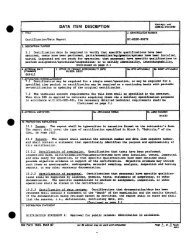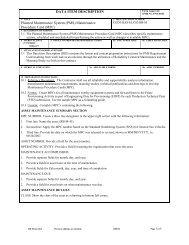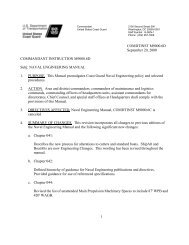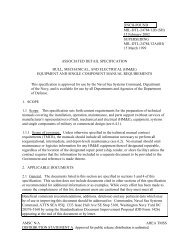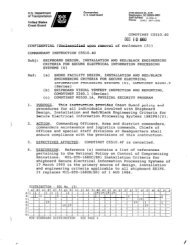comdtinst m2400.1f - US Coast Guard Response Boat-Medium
comdtinst m2400.1f - US Coast Guard Response Boat-Medium
comdtinst m2400.1f - US Coast Guard Response Boat-Medium
Create successful ePaper yourself
Turn your PDF publications into a flip-book with our unique Google optimized e-Paper software.
CHAPTER 6 GLOBAL MARITIME DISTRESS AND SAFETY SYSTEM<br />
A. System Principles and Objectives.<br />
1. IMO. The international Maritime Organization (IMO) has<br />
developed a Global Maritime Distress and Safety System (GMDSS)<br />
planned for implementation during the period between 1 Feb<br />
1992 and 1 Feb 1999. It has been implemented through 1988<br />
Amendment to the Safety of Life at Sea (SOLAS) Convention<br />
which has treaty status in the <strong>US</strong>. This new system builds on<br />
the present system and incorporates significant changes in<br />
both concept and technique. The present system is primarily a<br />
ship-to-ship system; however, it also provides for distress<br />
communications between ships and the shore. The system uses<br />
three international distress frequencies; 156.8 MHz, 2182 kHz<br />
and 500 kHz. The first two frequencies employ voice<br />
radiotelephony, the third morse radio telegraphy. Currently,<br />
it is a short and medium range system, although morse<br />
telegraphy on 500 kHz can extend the medium ranges to<br />
distances around 500 miles. The objective for the CMDSS is<br />
to establish a universal and effective distress system<br />
providing long range (global) communications using maritime<br />
satellites complemented by a series of international HF<br />
distress frequencies and, for shorter ranges, by 2 MHz and VHF<br />
frequencies. Distress traffic at long ranges will be obtained<br />
by a comprhensive shore-based communications network, the key<br />
feature of which will be the establishment of a system of<br />
Rescue Coordination Centers (RCC). Aleting and watchkeeping<br />
will be carried out automatically - either by satellite or on<br />
terrestial frequencies using Digital Selective Calling (DSC)<br />
techniques. The unit in distress, including survival craft,<br />
will transmit distress alerts to RCCs and to shipping in the<br />
vicinity. The RCCs will alert units able to assist and, if<br />
necessary, will coordinate the rescue operation. Follow-up<br />
traffic will be sent using voice radiotelephony and/or narrow<br />
band dirrect printng (NBDP), (also called SITOR or radio<br />
telex). Morse radiotelegraphy will not be used for distress<br />
and safety purposes under the new system.





